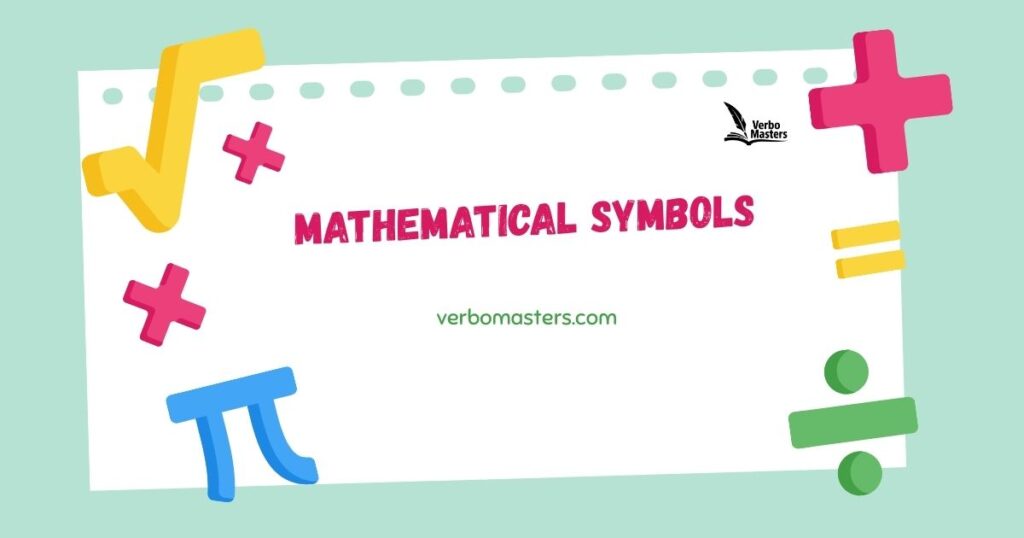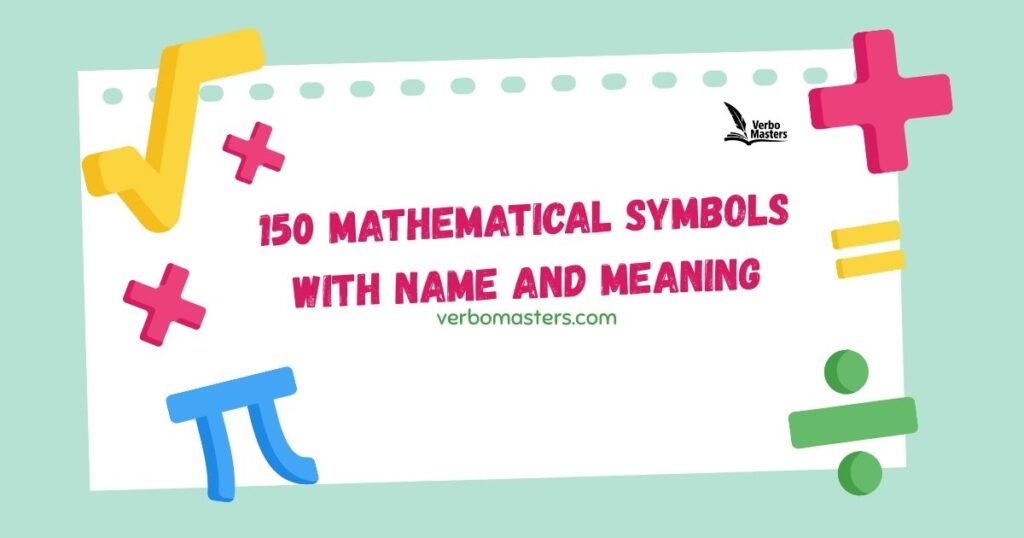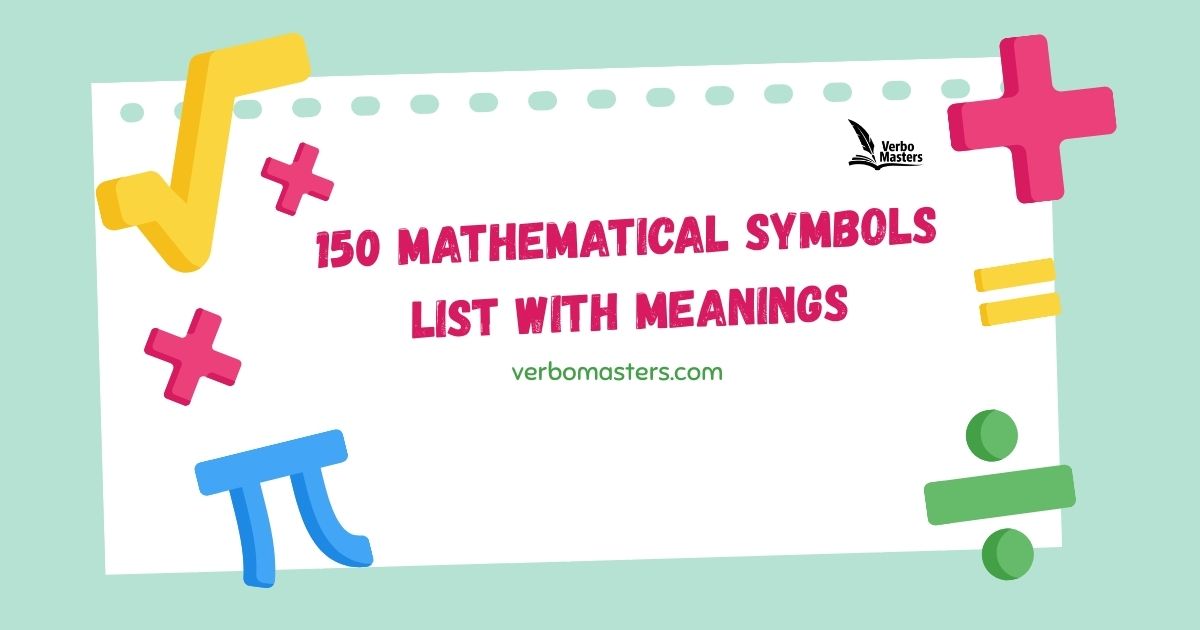Mathematical Symbols List With Meanings! Math is a universal language, and symbols are its alphabet.
These tiny marks help us explain big ideas in simple ways.
Whether you’re solving equations or graphing a line, symbols matter.
They make communication easier across all levels of math.
From basic addition to complex calculus, symbols guide the way.
Even in everyday life, we use math symbols without realizing it.
Learning them helps make problem-solving faster and clearer.
This list will help you understand 150 important math symbols with meanings.
You can also read; 150 words to describe the Ocean
Mathematical Symbols

150 mathematical symbols along with their names/meanings.
Basic Arithmetic Symbols
- + – Plus
- − – Minus
- × – Multiplication
- ÷ – Division
- = – Equals
- ≠ – Not equal
- < – Less than
- > – Greater than
- ≤ – Less than or equal to
- ≥ – Greater than or equal to
- ± – Plus or minus
- ∓ – Minus or plus
- % – Percent
- ‰ – Per mille
- √ – Square root
- ∛ – Cube root
- ∜ – Fourth root
- ! – Factorial
- ÷ – Obelus (division symbol)
- mod – Modulus
Algebra and Number Theory
- ≡ – Identical to
- ≈ – Approximately equal
- ≅ – Congruent to
- ∝ – Proportional to
- ∈ – Element of
- ∉ – Not an element of
- ⊂ – Subset of
- ⊃ – Superset of
- ⊆ – Subset or equal
- ⊇ – Superset or equal
- ∩ – Intersection
- ∪ – Union
- ∅ – Empty set
- ℕ – Set of natural numbers
- ℤ – Set of integers
- ℚ – Set of rational numbers
- ℝ – Set of real numbers
- ℂ – Set of complex numbers
- ⊕ – Direct sum
- ⊗ – Tensor product
Geometry and Trigonometry
- ∠ – Angle
- ∟ – Right angle
- ⊥ – Perpendicular
- ∥ – Parallel
- ° – Degree
- ‘ – Minute (angle)
- ” – Second (angle)
- π – Pi
- △ – Triangle
- ◯ – Circle
Set Theory and Logic
- ⇒ – Implies
- ⇔ – If and only if
- ¬ – Not
- ∧ – And
- ∨ – Or
- ⊤ – True
- ⊥ – False
- ∀ – For all
- ∃ – There exists
- ∄ – There does not exist
- ∴ – Therefore
- ∵ – Because
- ⊢ – Proves
- ⊨ – Models
- ⊩ – Forces
- ⊬ – Does not prove
- ⊭ – Does not model
- ≡ – Equivalent
Calculus and Analysis
- d – Differential
- ∫ – Integral
- ∬ – Double integral
- ∭ – Triple integral
- ∮ – Contour integral
- ∇ – Nabla (del operator)
- ∂ – Partial derivative
- ∞ – Infinity
- lim – Limit
- ∑ – Summation
- ∏ – Product
- Δ – Change
- ε – Epsilon (a very small number)
- → – Tends to
- ↦ – Maps to
- ≜ – Defined as
Matrices and Vectors
- → – Vector
- |A| – Determinant of A
- T – Transpose
- A⁻¹ – Inverse of matrix A
- I – Identity matrix
- · – Dot product
- × – Cross product
- ‖v‖ – Norm of vector v
- λ – Eigenvalue
- Σ – Covariance matrix
- diag – Diagonal matrix
Probability and Statistics
- P(A) – Probability of event A
- E(X) – Expected value
- Var(X) – Variance
- σ – Standard deviation
- μ – Mean
- X ~ N(μ, σ²) – X follows a normal distribution
- ∈ – Belongs to
- ≅ – Approximately equal distribution
- ρ – Correlation coefficient
- 𝑝̂ – Sample proportion
Greek Letters Common in Math
- α – Alpha
- β – Beta
- γ – Gamma
- δ – Delta
- ε – Epsilon
- ζ – Zeta
- η – Eta
- θ – Theta
- ι – Iota
- κ – Kappa
- λ – Lambda
- μ – Mu
- ν – Nu
- ξ – Xi
- ο – Omicron
- π – Pi
- ρ – Rho
- σ – Sigma
- τ – Tau
- υ – Upsilon
- φ – Phi
- χ – Chi
- ψ – Psi
- ω – Omega
Other Miscellaneous Symbols
- ⊄ – Not a subset
- ≜ – Equal by definition
- ⋂ – Big intersection
- ⋃ – Big union
- ⊞ – Box plus
- ⊖ – Minus sign
- ⊙ – Circled dot
- ⋅ – Centered dot (multiplication)
- ↔ – Left-right arrow
- ↕ – Up-down arrow
- ∠ABC – Angle between points A, B, and C
- ℓ – Line
- … – Ellipsis
- ∎ – End of proof
- ⊅ – Not a superset
- ∥x∥ – Norm or magnitude
- # – Number (count)
- || – Parallel or absolute value bars
- :≡ – Defined as
- ≐ – Approaches
- ⇑ – Implies strongly / upward trend
150 Mathematical symbols with name and meaning

150 mathematical symbols with their names and meanings, presented.
| Symbol | Name | Meaning |
| + | Plus | Addition |
| − | Minus | Subtraction |
| × | Multiplication | Multiply numbers |
| ÷ | Division | Divide numbers |
| = | Equal | Equality |
| ≠ | Not Equal | Values are not equal |
| < | Less Than | Smaller than |
| > | Greater Than | Larger than |
| ≤ | Less Than or Equal | Smaller than or equal |
| ≥ | Greater Than or Equal | Larger than or equal |
| ± | Plus Minus | Both positive and negative |
| ∓ | Minus Plus | Used with ± to denote opposite sign |
| % | Percent | Per hundred |
| √ | Square Root | Root of a number |
| ∛ | Cube Root | Cube root of a number |
| ∜ | Fourth Root | Fourth root of a number |
| ! | Factorial | Product of all positive integers ≤ n |
| ∑ | Summation | Sum of terms |
| ∏ | Product | Product of terms |
| ∫ | Integral | Area under a curve |
| ∬ | Double Integral | Integral over two variables |
| ∭ | Triple Integral | Integral over three variables |
| ∂ | Partial Derivative | Derivative with respect to one variable |
| d/dx | Derivative | Instantaneous rate of change |
| ∞ | Infinity | Goes on forever |
| ≈ | Approximately Equal | Close in value |
| ~ | Tilde | Similar or proportional |
| ≅ | Congruent | Exactly equal in shape/size |
| ≡ | Identically Equal | Equal in all cases |
| ∝ | Proportional To | One value increases with another |
| ∈ | Element Of | Belongs to a set |
| ∉ | Not Element Of | Does not belong to a set |
| ⊂ | Subset | All elements are in another set |
| ⊃ | Superset | Contains all elements of another set |
| ⊆ | Subset or Equal | Can be equal or a subset |
| ⊇ | Superset or Equal | Can be equal or a superset |
| ∅ | Empty Set | A set with no elements |
| { } | Set Braces | Denote a set |
| ∩ | Intersection | Common elements of sets |
| ∪ | Union | All elements in both sets |
| ∖ | Set Difference | Elements in one set but not the other |
| A | ||
| ∠ | Angle | Measure of rotation |
| ⊥ | Perpendicular | At right angles |
| ∥ | Parallel | Lines never intersect |
| ° | Degree | Unit of angle or temperature |
| ′ | Prime | Derivative or minutes |
| ″ | Double Prime | Second derivative or seconds |
| ∴ | Therefore | Logical conclusion |
| ∵ | Because | Reasoning or explanation |
| ⇒ | Implies | Logical implication |
| ⇔ | If and Only If | Biconditional statement |
| ∃ | There Exists | At least one exists |
| ∄ | There Does Not Exist | No such element exists |
| ∀ | For All | Statement applies to all elements |
| ∋ | Contains As Member | Set contains the element |
| ⊢ | Provable | Can be proven |
| ⊨ | Models | Satisfies a logical formula |
| ⊻ | Exclusive Or | One or the other, not both |
| ⊕ | Direct Sum | Vector space operation |
| ⊗ | Tensor Product | Matrix or vector operation |
| ⊞ | Boxplus | XOR in logic or addition |
| ⊖ | Circled Minus | Subtraction in some algebra |
| ∸ | Minus Sign with Dot | Special subtraction |
| ⋅ | Dot Product | Scalar product of vectors |
| ∘ | Function Composition | Applying one function to another |
| → | Tends To / Implies | Approaches a limit or direction |
| ← | Left Arrow | Direction or logic |
| ↔ | Left-Right Arrow | Equivalence in logic |
| ↦ | Maps To | Function mapping |
| ⟶ | Long Right Arrow | Extended direction |
| ∥x∥ | Norm | Magnitude of vector |
| x | ||
| ⊤ | Top (Truth) | Logical truth |
| ⊥ | Bottom (Falsehood) | Logical falsehood |
| ⊩ | Entails | Semantic consequence |
| ℕ | Natural Numbers | 1, 2, 3, … |
| ℤ | Integers | …, -2, -1, 0, 1, 2, … |
| ℚ | Rational Numbers | Fractions |
| ℝ | Real Numbers | All rational and irrational numbers |
| ℂ | Complex Numbers | Numbers with real and imaginary parts |
| ℙ | Prime Numbers | 2, 3, 5, 7, … |
| ℵ₀ | Aleph Null | Countable infinity |
| mod | Modulo | Remainder after division |
| ⌊x⌋ | Floor | Greatest integer ≤ x |
| ⌈x⌉ | Ceiling | Smallest integer ≥ x |
| ⊬ | Not Provable | Cannot be proven |
| ∆ | Delta | Change or difference |
| ∇ | Nabla (Del) | Gradient or vector derivative |
| ∠ABC | Angle ABC | Named angle with points |
| log | Logarithm | Inverse of exponentiation |
| ln | Natural Logarithm | Log base e |
| e | Euler’s Number | Approximately 2.718 |
| π | Pi | Approximately 3.1416 |
| i | Imaginary Unit | √-1 |
| ∴ | Therefore | Used before conclusions |
| ∵ | Because | Indicates a reason or cause |
| ∎ | End of Proof (Tombstone) | Proof completed |
| ⟹ | Strong Implication | A strong form of logical implication |
| ⟺ | Strong Equivalence | Strong logical equivalence |
| ∇f | Gradient | Vector of partial derivatives |
| argmax | Argument of Maximum | Value that maximizes a function |
| argmin | Argument of Minimum | Value that minimizes a function |
| det | Determinant | Matrix determinant |
| rank | Rank | Dimension of matrix column space |
| tr | Trace | Sum of diagonal elements |
| ∥A∥ | Norm of Matrix A | Matrix size measure |
| A⁻¹ | Inverse Matrix | Matrix that reverses multiplication |
| T | Transpose | Swapping rows and columns |
| ⊤, ⊥ | Top, Bottom | Logical truth and falsehood |
| ⊆, ⊈ | Subset, Not Subset | Set relations |
| ⊇, ⊉ | Superset, Not Superset | Set relations |
FAQs
What is a mathematical symbol?
A mathematical symbol is a character used to represent a mathematical concept, operation, or relation. For example, “+” represents addition, while “×” represents multiplication.
Why are mathematical symbols important?
Mathematical symbols help simplify and communicate complex mathematical concepts. They make equations and operations easier to write and understand across different languages and cultures.
What is the meaning of the symbol “∑“?
The symbol “∑” represents summation, or the process of adding up a sequence of numbers or terms. It is often used to represent the sum of elements in a series.
What does “√” mean in mathematics?
The “√” symbol stands for square root. It is used to represent the number that, when multiplied by itself, gives the original number.
What is the significance of the symbol “∞”?
The symbol “∞” represents infinity, indicating a value that is unbounded or limitless. It is used to describe quantities that grow without end.
How do you use the symbol “≠”?
The “≠” symbol means “not equal to.” It is used to compare two values and show that they are not the same.
What is a factorial, represented by “!”?
A factorial, denoted by “!”, is the product of all positive integers up to a given number. For example, 5! = 5 × 4 × 3 × 2 × 1 = 120.
What does the symbol “∩” represent?
The symbol “∩” represents the intersection of two sets. It shows the elements that are common to both sets.
What does the “∪” symbol mean?
The “∪” symbol represents the union of two sets. It includes all elements that are in either set, without duplication.
What is the use of the “≈” symbol?
The “≈” symbol means “approximately equal to.” It is used when two values are close but not exactly the same.
Conclusion
Mathematics is a universal language, and symbols play a key role in its communication. They provide a shared framework that allows people from all over the world to engage with mathematical ideas. This makes mathematics a global field, not confined by borders.
Symbols like “∞” for infinity or “≠” for not equal to make abstract concepts more tangible. They help simplify complex thoughts, making them easier to understand and work with. These symbols are used in every area of life, from the classroom to the workplace.

I’m John Smith, a language enthusiast dedicated to helping writers, students, and professionals master the art of clear and effective communication. Whether you’re looking for grammar tips, writing guides, or common mistake corrections, you’ll find valuable insights to improve your language skills. Let’s make grammar simple and fun!

